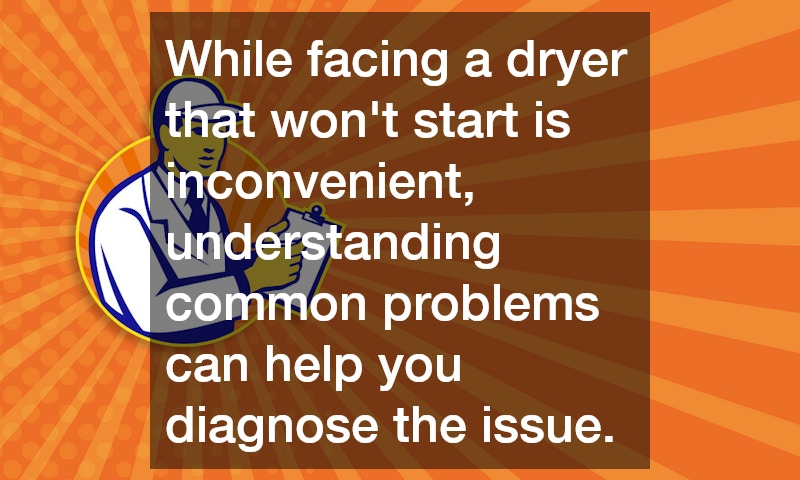Having a dryer that won’t start can be frustrating and inconvenient. Before calling in a dryer repair technician, it’s helpful to understand some of the common reasons why your dryer might not be working. This article explores four frequently encountered issues that could be the culprit and offers tips on how to address them.
1. Is the Dryer Plugged in and Getting Power?
Checking the Power Source
Ensure the dryer is properly plugged into a functioning power outlet. Sometimes, outlets can trip and stop providing electricity, which can be verified by testing with another appliance. Additionally, a malfunctioning outlet may require an electrician’s professional assessment for safety. Power surges or electrical storms can sometimes impact your appliance outlets. Ensuring your outlet is protected by a surge protector can prevent potential future disruptions.
Inspecting the Circuit Breaker
Check the circuit breaker to see if it has tripped. Circuit breakers are designed to prevent electrical overloads by cutting off power supply, which can protect your home from fires. By resetting the breaker, you might restore power to your dryer effortlessly. Repeated tripping of the circuit breaker might indicate a deeper electrical problem in your home. Regular tripping might suggest that the circuit is overloaded with too many appliances. In such scenarios, consulting with a licensed electrician can offer a permanent solution.
Is the Door Switch Working?
Understanding the Door Switch Function
The door switch is a safety feature that prevents the dryer from operating when the door is open. Recognizing this component’s critical role can help you identify why your dryer might not start. It ensures safety by preventing the dryer drum from turning until the door is securely closed. Ignoring the door switch function can lead to unnecessary anxiety about a non-starting dryer. Familiarizing yourself with how the switch works can aid in accurately diagnosing starting issues. Where the switch lies in the dryer assembly may vary depending on the model, but its functionality remains consistent across different appliances.
Testing the Door Switch
Manually press the door switch and listen for a distinct clicking sound. This sound indicates that the switch is engaging correctly and allowing the dryer to start. If absent, the switch may be faulty and need replacing. Door switch functionality is typically straightforward to test with minimal tools. A continuity tester or multimeter can further diagnose the internal functionality of the switch.
3. Could the Thermal Fuse Be Blown?
Function of the Thermal Fuse
The thermal fuse acts as a safety mechanism that shuts off the dryer to prevent overheating. It is a crucial component, guarding against potentially hazardous temperature rises. Understanding its role can clarify why your dryer might cease working unexpectedly. Unlike other replaceable parts, the thermal fuse is designed to be a one-time-use component. If triggered, it requires a replacement to restore dryer functionality.
Identifying a Blown Thermal Fuse
Symptoms of a blown thermal fuse include the dryer failing to start altogether. Familiar signs may include a completely unresponsive appliance and a lack of heat when the unit is turned on. Confirm the diagnosis with a multimeter test, which checks for electrical continuity. The multimeter test involves setting the device to the continuity or resistance function. A working thermal fuse shows continuous electrical flow, whereas a blown fuse does not.
4. Could There Be a Problem with the Motor?
Symptoms of a Failing Motor
A dryer motor that doesn’t start may cause buzzing sounds. These sounds are indicative of the motor attempting to start but failing due to internal faults. Recognizing early symptoms of motor trouble can prevent complete appliance failure. The dryer motor is pivotal in powering the drum, enabling effective drying cycles. An impaired motor might inhibit your dryer’s essential functions, rendering it useless.
Diagnosing Motor Problems
Use diagnostic steps to determine if the motor is at fault. Initial assessments often include checking the motor windings and looking for signs of wear or overheating. Consulting the dryer’s technical manual can offer additional guidance for motor inspection. Diagnostic tests might require specialized tools, like a multimeter, to assess electrical continuity. It’s crucial to differentiate between an internal motor fault and external issues affecting motor performance.
While facing a dryer that won’t start is inconvenient, understanding these common problems can help you quickly diagnose and address the issue. By exploring the power source, door switch, thermal fuse, and motor, you can determine whether a simple DIY fix or professional help is needed. Taking these steps may save you time and money while preventing further damage to your appliance.


